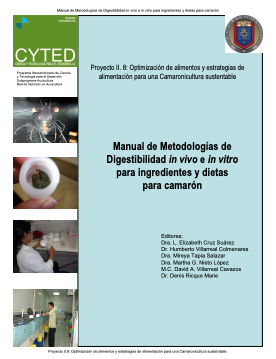Development of Value-Added Products in Aquaculture
Palabras clave:
aquaculture, value-added seafood, technologyResumen
Aquaculture is becoming increasingly important in satisfying consumer demands for good quality seafood. It has maintained a steady, positive growth over the years when compared to marine fisheries and is supplying the nutritional needs for both developed and developing countries. While aquaculture has supplied fresh fish and shellfish to global markets, there is an increasing opportunity for expanding value-added products. There are several advantages to value-added processing, including creating safer products, preserving high quality characteristics, extending shelf-life and enhancing economic return to the producer/processor. Value-added products can come in several forms including traditional processed products; market-driven products that have a steady or increasing demand; health-driven seafood, which is becoming an increasingly important niche, values-driven product that is focused more on environmental concerns and social issues, and technology-driven seafood products which often adds safety as well as quality characteristics to products. These different opportunities for aquaculture will be discussed in detail. Value-added processing will play an important role in the growing aquaculture sector to help meet demands of the consumer for safe, wholesome, high-quality seafood products.Descargas
Citas
Abend, L. and Mayor, I. (2009) Sustainable aquaculture: net profits. Time magazine, June 15. http://www.time.com/time/magazine/article/0,9171,1902751,00.html
Bang HO & Dyerberg J. (1980) Lipid metabolism and ischemic heart disease in Greenland Eskimos. In: Draper, H., editor). Advances in Nutrition Research. New York, NY: Plenum Press. p. 1-22.
Barry, U. (2010) Annual report on the United States seafood industry. www.urnerbarry.com
Belton, B., Haque, M.M., Little, D.C., Sinh, L.X. (2011) Certifying catfish in Vietnam and Bangledesh: who will make the grade and will it matter. Food Policy, 36: 289-299.
Brenna JT & Lapillonne A. (2009) Background paper on fat and fatty acid requirements during pregnancy and lactation. Ann. Nutr. Metab. 55(1-3):97-122.
Calik, H., Morrissey, M.T., Reno, P., and An, H. (2002) Effect of high-pressure processing on Vibrio parahaemolyticus strains in pure culture and Pacific oysters. J. Food Sci. 67(4): 1506-1510.
Cressey, D. (2009) Aquaculture: future fish. Nature 458, 398-400. Online at: http://www.nature.com/news/2009/090325/full/458398a.html
Downey, R. (2009) Canaries in a coal mine: what oysters can teach u about ocean acidification. Northwest Shefish Growers Association, Olympia, WA http://www.seafoodchoices.com/whatwedo/profile_pcsgaOA.php
Cacciola, J. (2010) The Chef and the oyster farmer. http://www.slashfood.com/2010/09/24/the-chef-and-the-oyster-farmer
Cooper, R.G. and Edgett, S.J. (2005) Lean Rapid and Profitable New Product Development. Basic Books, NY.
DGAC. (2010) Report of the Dietary Guidelines Advisory Committee on the DietaryGuidelines for Americans, 2010. USDA Center for Nutrition Policy and Promotion. http://www.cnpp.usda.gov/dietaryguidelines.htm.
FAO. (2010) Fisheries and Aquaculture. http://www.fao.org/fishery/statistics/en FAO/WHO. (2008) Interim Summary of Conclusions and Dietary Recommendations on Total Fat & Fatty Acids. From the Joint FAO/WHO Expert Consultation on Fats and Fatty Acids in Human Nutrition, 10-14 November, 2008, WHO, Geneva. http://www.fao.org/ag/agn/nutrition/requirements_en.stm.
Delgado, C.L., Wada, N., Rosegrant, M.W., Meijer, S., and Ahmed, M. (2003) Fish to 2020 Supply and Demand in Changing Global Markets. Jointly published by the International Food Policy Research Institute (IFPRI) and Worldfish Center, Penang, Malaysia.
FAO. (2006) State of the World Fisheries and Aquaculture. Food and Agriculture Organization, Rome, Italy. ftp://ftp.fao.org/docrep/fao/009/a0699e/a0699e.pdf
Friedrick, J. 2009Through ups and downs, tilapia maintains its popularity. 2009. Seafood Business, October 1. http://www.seafoodbusiness.com/articledetail.aspx?id=4294999304
Gulbrandsen, L. H. (2009) The emergence and effectiveness of the Marine Stewardship Council. Marine Policy 33(4): 654-660.
He, H., Adams, R., Farkas, D., and Morrissey, M.T. (2002) Use of high-pressure processing for oyster shucking and shelf-life extension. J. Food Sci. 67(2): 640-45.
He K, Song Y, Daviglus ML, Liu K, Van Horn L, Dyer AR, Goldbourt U & Greenland P. (2004) Fish consumption and incidence of stroke: a meta-analysis of cohort studies. Stroke 35:1538-1542.
Hunter, B.J. and Roberts, D. (2000) Potential impact of the fat composition of farmed fish on human health. Nutrition Research. 20(7): 1047-1058.
IOM (Institute of Medicine) (2005) Seafood choices: balancing benefits and risks/Committee on Nutrient Relationships in Seafood: Selections to Balance Benefits and Risks, Food and Nutrition Board. Washington, D.C.: National Academy of Sciences.
Johnson, H.M. (2004) 2004, Annual Report on the United States seafood industry. H.M. Johnson & Associates, Jacksonville, OR.
König A, Bouzan C, Cohen JT, Connor WE, Kris-Etherton PM, Gray GM, Lawrence RS, Savitz DA & Teutsch SM. (2005) A quantitative analysis of fish consumption and coronary heart disease mortality. Amer. J. Prev. Med. 29(4):335-346.
Kromhout D, Bosschieter EB & de Lezenne Coulander C. (1985) The inverse relationship between fish consumption and 20-year mortality from coronary heart disease. N. Engl. J. Med. 312(19):1205-1209.
Liu, C., Lu, J. and Su, Y.C. (2009) Effects of Flash Freezing, Followed by Frozen Storage, on Reducing Vibrio parahaemolyticus in Pacific Raw Oysters (Crassostrea gigas). J. Food Protection 72 (1); 174-177.
Mozaffarian D. (2008) Fish and n-3 fatty acids for the prevention of fatal coronary heart disease and sudden cardiac death. Am J Clin Nutr 87(6):1991S-1996.
Mozaffarian D & Rimm EB. (2006) Fish intake, contaminants, and human health: evaluating the risks and the benefits. JAMA 296:1885 - 1899.
MSC. (2010) Homepage: http://www.msc.org/
Russell, D. (2002) Tuna-dolphin wars. http://www.dickrussell.org/articles/tunadolphin.htm
Shiu, S-H. (1999) The Effect of High Hydrostatic Pressure in Reducing Total Plate Count and Extending Shelf-Life in Oysters, Ph.D. Thesis, Corvallis, OR.
Synder, W. (2009) The Specialist: rebranding the oyster. Wall Street Journal Magazine, Dec. 7. http://blogs.wsj.com/magazine/2009/12/07/re-branding-the-oyster
Styles, M.F., Hoover, D., and farkas, D.F. (1991) Response of Listeria monocytogenesand Vibrio parahaemolyticus to High Hydrostatic Pressure. J. Food Sci. 56(5): 1404-1407.
Van Gelder BM, Tijhuis M, Kalmijn S & Kromhout D. (2007) Fish consumption, n-3 fatty acids, and subsequent 5-y cognitive decline in elderly men: the Zutphen Elderly Study.
Am. J. Clin. Nutr. 85(4):1142-1147.
WHO. (2002) Reducing risks, promoting healthy life. The World Health Report 2002. Accessible at: http://www.who.int/whr/2002/en/.
Williams CM & Burdge G. (2006) Long-chain n-3 PUFA: plant v. marine sources. Proc. Nutr. Soc. 65:42-50.
WSJ (Wall Street Journal). (2009) A fish by any other name. http://online.wsj.com/article/SB124276314037135959.html





